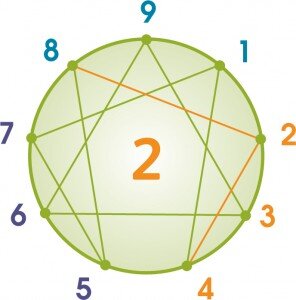Myth Busting: Type 2 The People Pleaser
 When people describe or think of Enneagram Type 2 The People Pleaser, you often hear about a selfless person, Mother Teresa, self-sacrifice for the benefit of others ... The moon to the sun ... Someone who may not take care of his or her appearance while preoccupied with taking care of and pleasing others ... Someone who is worn down and worn out ... A doormat.The stereotype: The nurse, the social work, the volunteer at the homeless shelter, the doctor, the nurturer ...Let's bust this myth. Type 2s can be hedonistic--pleasure seekers--something oft attributed to Type 7 The Enthusiast or Type 8 The Boss.For Type 2, physical attractiveness is important. Type 2s are the great seducers of the Enneagram and appearance is an important part of that. Type 2s are Image Types (along with Types 3 The Achiever and 4 The Individualist).This means they are attentive to the image they project to others by what they say, how they look and what they do. They care about what others think often more than the other Types, and are more likely to take things personally.Type 2s and Type 3s: Type 2s can be well groomed, well coiffed and dressed to suit the situation. Type 3s are often described as the chameleons of the Enneagram, however Type 2s can share this same ability by becoming what others need them to be. They tend to be quite empathic and are able shapeshift to endear themselves to important others. Type 3s are also considered "sparkly" yet many Type 2s also fit that description. Like Type 3s, they can be social climbers--they just go about it differently and for different reasons.Type 2s are not always behind the scenes--the power behind the throne or the moon to the sun. While this can be true, what is also true is that many Type 2s are ambitious.Type 2s I know lead organizations, start their own for-profit and non-profit organizations, are VPs of Human Resources, sales directors, run customer service departments, manage medical staff, own and operate social media organizations and yoga studios ... they perform, sing, act, paint.Type 2s are happy to go after their dreams and make them a reality.Type 7 The Enthusiast and Type 3 The Achiever are often described as charming and to some extent, so is Type 8 The Boss. However, Type 2s are also known to be quite charming in order to achieve their ends. They can be competitive, organized, and perfectionistic.They take strong stands, are willful, make demands and fully assert themselves.In other words, people don't just walk all over them. They are not doormats. But they can be.At this point, you may be wondering, "What's the difference then, between Type 2 and Type 3 or some of the other Types if they share common behaviors?"Great question!IMPORTANT: What distinguishes one Type from another is not so much the behaviors we see, but why the different Types do what they do. In other words, what are their underlying motivations--what needs are they trying to get met and what are they trying to avoid?Type 2s' strategy is to please others in order to garner appreciation and make themselves indispensable. Much of their self-worth is based upon feeling valued, needed, and appreciated by others. On a deeper level, Type 2s' self-perception is that they are unloveable. When they feel appreciated, desired, indispensable and valued, they temporarily feel lovable.
When people describe or think of Enneagram Type 2 The People Pleaser, you often hear about a selfless person, Mother Teresa, self-sacrifice for the benefit of others ... The moon to the sun ... Someone who may not take care of his or her appearance while preoccupied with taking care of and pleasing others ... Someone who is worn down and worn out ... A doormat.The stereotype: The nurse, the social work, the volunteer at the homeless shelter, the doctor, the nurturer ...Let's bust this myth. Type 2s can be hedonistic--pleasure seekers--something oft attributed to Type 7 The Enthusiast or Type 8 The Boss.For Type 2, physical attractiveness is important. Type 2s are the great seducers of the Enneagram and appearance is an important part of that. Type 2s are Image Types (along with Types 3 The Achiever and 4 The Individualist).This means they are attentive to the image they project to others by what they say, how they look and what they do. They care about what others think often more than the other Types, and are more likely to take things personally.Type 2s and Type 3s: Type 2s can be well groomed, well coiffed and dressed to suit the situation. Type 3s are often described as the chameleons of the Enneagram, however Type 2s can share this same ability by becoming what others need them to be. They tend to be quite empathic and are able shapeshift to endear themselves to important others. Type 3s are also considered "sparkly" yet many Type 2s also fit that description. Like Type 3s, they can be social climbers--they just go about it differently and for different reasons.Type 2s are not always behind the scenes--the power behind the throne or the moon to the sun. While this can be true, what is also true is that many Type 2s are ambitious.Type 2s I know lead organizations, start their own for-profit and non-profit organizations, are VPs of Human Resources, sales directors, run customer service departments, manage medical staff, own and operate social media organizations and yoga studios ... they perform, sing, act, paint.Type 2s are happy to go after their dreams and make them a reality.Type 7 The Enthusiast and Type 3 The Achiever are often described as charming and to some extent, so is Type 8 The Boss. However, Type 2s are also known to be quite charming in order to achieve their ends. They can be competitive, organized, and perfectionistic.They take strong stands, are willful, make demands and fully assert themselves.In other words, people don't just walk all over them. They are not doormats. But they can be.At this point, you may be wondering, "What's the difference then, between Type 2 and Type 3 or some of the other Types if they share common behaviors?"Great question!IMPORTANT: What distinguishes one Type from another is not so much the behaviors we see, but why the different Types do what they do. In other words, what are their underlying motivations--what needs are they trying to get met and what are they trying to avoid?Type 2s' strategy is to please others in order to garner appreciation and make themselves indispensable. Much of their self-worth is based upon feeling valued, needed, and appreciated by others. On a deeper level, Type 2s' self-perception is that they are unloveable. When they feel appreciated, desired, indispensable and valued, they temporarily feel lovable.
None of the Enneagram Type strategies work over time, but they give us the sense that our needs are being met, much like eating provides a temporary sensation that we are full and satisfied.
For this reason, Type 2 wants to avoid loss of connection--loss of love and their source of appreciation--and will go to great lengths to maintain those connections, often at risk of harm to themselves, and to others. This is when some of the more stereotypical behavior can show up. Another reason Type 2 can share common behaviors with Type 3 The Achiever and Type 1 The Perfectionist is that these Types are the Wings of Type 2. The theory I find most useful and the one that maps to my observations, is that Type is a blend of the two Wings. From my book, InsideOut Enneagram: The Game-Changing Guide for Leaders:Wings: The points on both sides of your Type are called your Wings, and they influence the ways you express the characteristics of your Type. Some people relate more to one Wing than another. Others feel that they share qualities with both Wings. You’ll hear people say, “I’m a 2 with a 3 wing.” In other words, Type 2 blends Type 1 and Type 3, and displays characteristics of all three Types. When we don’t relate to one of our Wings, it is probably because it lives outside of our conscious awareness.Points of connection: Look at the Enneagram symbol and you'll see that Type 2 is connected to Types 8 and 4. Under certain circumstances, Type 2 has access to many of the characteristic behaviors of these two Types.At their best, Type 2s are warm, reliable, able to receive help graciously ... They give without expectation, build powerful and durable alliances, are brilliant at making connections and building relationships and know who they are, what they stand for and that they are lovable for who they are and not what they do.I hope this post offers a more well-rounded picture of Type 2 than the one you may have had. Remember, there is a Type 2 People Pleaser in all of us!Please comment and let us know your own experience with Type 2s or from the perspective of Type 2. We would all benefit from your stories.________________________________________________________________Postscript: A couple of years ago, in a conversation with Bea Chestnut, PhD Psychologist, Coach, Enneagram teacher and Type 2 ... she noted that most people don't get the hedonistic side of Type 2. I thought, "she's right!" We over-focus on other aspects. It is in the spirit of illustrating a much broader picture of Type 2, that I wrote this blog. Thank you, Bea!
Another reason Type 2 can share common behaviors with Type 3 The Achiever and Type 1 The Perfectionist is that these Types are the Wings of Type 2. The theory I find most useful and the one that maps to my observations, is that Type is a blend of the two Wings. From my book, InsideOut Enneagram: The Game-Changing Guide for Leaders:Wings: The points on both sides of your Type are called your Wings, and they influence the ways you express the characteristics of your Type. Some people relate more to one Wing than another. Others feel that they share qualities with both Wings. You’ll hear people say, “I’m a 2 with a 3 wing.” In other words, Type 2 blends Type 1 and Type 3, and displays characteristics of all three Types. When we don’t relate to one of our Wings, it is probably because it lives outside of our conscious awareness.Points of connection: Look at the Enneagram symbol and you'll see that Type 2 is connected to Types 8 and 4. Under certain circumstances, Type 2 has access to many of the characteristic behaviors of these two Types.At their best, Type 2s are warm, reliable, able to receive help graciously ... They give without expectation, build powerful and durable alliances, are brilliant at making connections and building relationships and know who they are, what they stand for and that they are lovable for who they are and not what they do.I hope this post offers a more well-rounded picture of Type 2 than the one you may have had. Remember, there is a Type 2 People Pleaser in all of us!Please comment and let us know your own experience with Type 2s or from the perspective of Type 2. We would all benefit from your stories.________________________________________________________________Postscript: A couple of years ago, in a conversation with Bea Chestnut, PhD Psychologist, Coach, Enneagram teacher and Type 2 ... she noted that most people don't get the hedonistic side of Type 2. I thought, "she's right!" We over-focus on other aspects. It is in the spirit of illustrating a much broader picture of Type 2, that I wrote this blog. Thank you, Bea!
Check out these links for more information:
What is the Enneagram?Enneagram Type DescriptionsEnneagram Case StudiesInsideOut Enneagram: The Game-Changing Guide for LeadersEnneagram Typing Cards
Blog Posts:
- Q & A About the Enneagram
- The Three Instincts
- It's The Journey, Not the Destination
- Misunderstood: Type 4 The Individualist
- A Story of Team Dynamics
- Case Study: Type 8 & 9 (Boss and direct report)
- Use of Typing Cards for Your Relationship
- Coaching Type 2 The People Pleaser
- Enneagram Typing Using a Narrative Approach

